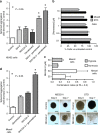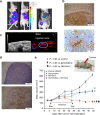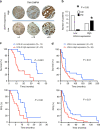Impact of hypoxia on chemoresistance of mesothelioma mediated by the proton-coupled folate transporter, and preclinical activity of new anti-LDH-A compounds
- PMID: 32493992
- PMCID: PMC7434895
- DOI: 10.1038/s41416-020-0912-9
Impact of hypoxia on chemoresistance of mesothelioma mediated by the proton-coupled folate transporter, and preclinical activity of new anti-LDH-A compounds
Abstract
Background: Expression of proton-coupled folate transporter (PCFT) is associated with survival of mesothelioma patients treated with pemetrexed, and is reduced by hypoxia, prompting studies to elucidate their correlation.
Methods: Modulation of glycolytic gene expression was evaluated by PCR arrays in tumour cells and primary cultures growing under hypoxia, in spheroids and after PCFT silencing. Inhibitors of lactate dehydrogenase (LDH-A) were tested in vitro and in vivo. LDH-A expression was determined in tissue microarrays of radically resected malignant pleural mesothelioma (MPM, N = 33) and diffuse peritoneal mesothelioma (DMPM, N = 56) patients.
Results: Overexpression of hypoxia marker CAIX was associated with low PCFT expression and decreased MPM cell growth inhibition by pemetrexed. Through integration of PCR arrays in hypoxic cells and spheroids and following PCFT silencing, we identified the upregulation of LDH-A, which correlated with shorter survival of MPM and DMPM patients. Novel LDH-A inhibitors enhanced spheroid disintegration and displayed synergistic effects with pemetrexed in MPM and gemcitabine in DMPM cells. Studies with bioluminescent hypoxic orthotopic and subcutaneous DMPM athymic-mice models revealed the marked antitumour activity of the LDH-A inhibitor NHI-Glc-2, alone or combined with gemcitabine.
Conclusions: This study provides novel insights into hypoxia/PCFT-dependent chemoresistance, unravelling the potential prognostic value of LDH-A, and demonstrating the preclinical activity of LDH-A inhibitors.
Conflict of interest statement
The authors declare no competing interests.
Figures





Similar articles
-
Role of proton-coupled folate transporter in pemetrexed resistance of mesothelioma: clinical evidence and new pharmacological tools.Ann Oncol. 2017 Nov 1;28(11):2725-2732. doi: 10.1093/annonc/mdx499. Ann Oncol. 2017. PMID: 28945836 Free PMC article.
-
Proton-coupled folate transporter as a biomarker of outcome to treatment for pleural mesothelioma.Pharmacogenomics. 2018 Jul 1;19(10):811-814. doi: 10.2217/pgs-2018-0071. Epub 2018 Jun 19. Pharmacogenomics. 2018. PMID: 29916298 No abstract available.
-
A specific inhibitor of lactate dehydrogenase overcame the resistance toward gemcitabine in hypoxic mesothelioma cells, and modulated the expression of the human equilibrative transporter-1.Nucleosides Nucleotides Nucleic Acids. 2016 Dec;35(10-12):643-651. doi: 10.1080/15257770.2016.1149193. Nucleosides Nucleotides Nucleic Acids. 2016. PMID: 27906635
-
The promise and challenges of exploiting the proton-coupled folate transporter for selective therapeutic targeting of cancer.Cancer Chemother Pharmacol. 2018 Jan;81(1):1-15. doi: 10.1007/s00280-017-3473-8. Epub 2017 Nov 10. Cancer Chemother Pharmacol. 2018. PMID: 29127457 Free PMC article. Review.
-
The human proton-coupled folate transporter: Biology and therapeutic applications to cancer.Cancer Biol Ther. 2012 Dec;13(14):1355-73. doi: 10.4161/cbt.22020. Epub 2012 Sep 6. Cancer Biol Ther. 2012. PMID: 22954694 Free PMC article. Review.
Cited by
-
The multiple roles of LDH in cancer.Nat Rev Clin Oncol. 2022 Dec;19(12):749-762. doi: 10.1038/s41571-022-00686-2. Epub 2022 Oct 7. Nat Rev Clin Oncol. 2022. PMID: 36207413 Review.
-
The Genes-Stemness-Secretome Interplay in Malignant Pleural Mesothelioma: Molecular Dynamics and Clinical Hints.Int J Mol Sci. 2023 Feb 9;24(4):3496. doi: 10.3390/ijms24043496. Int J Mol Sci. 2023. PMID: 36834912 Free PMC article. Review.
-
The Mechanism of Warburg Effect-Induced Chemoresistance in Cancer.Front Oncol. 2021 Sep 3;11:698023. doi: 10.3389/fonc.2021.698023. eCollection 2021. Front Oncol. 2021. PMID: 34540667 Free PMC article. Review.
-
Deciphering the tumour immune microenvironment cell by cell.Immunooncol Technol. 2023 Apr 7;18:100383. doi: 10.1016/j.iotech.2023.100383. eCollection 2023 Jun. Immunooncol Technol. 2023. PMID: 37234284 Free PMC article. Review.
-
Target Therapy in Malignant Pleural Mesothelioma: Hope or Mirage?Int J Mol Sci. 2023 May 23;24(11):9165. doi: 10.3390/ijms24119165. Int J Mol Sci. 2023. PMID: 37298116 Free PMC article. Review.
References
-
- Vogelzang NJ, Rusthoven JJ, Symanowski J, Denham C, Kaukel E, Ruffie P, et al. Phase III study of pemetrexed in combination with cisplatin versus cisplatin alone in patients with malignant pleural mesothelioma. J. Clin. Oncol. 2003;21:2636–2644. - PubMed
-
- Ceresoli GL, Zucali PA, Favaretto AG, Grossi F, Bidoli P, Del Conte G, et al. Phase II study of pemetrexed plus carboplatin in malignant pleural mesothelioma. J. Clin. Oncol. 2006;24:1443–1448. - PubMed
-
- Righi L, Papotti MG, Ceppi P, Billè A, Bacillo E, Molinaro L, et al. Thymidylate synthase but not excision repair cross-complementation group 1 tumor expression predicts outcome in patients with malignant pleural mesothelioma treated with pemetrexed-based chemotherapy. J. Clin. Oncol. 2010;28:1534–1539. - PubMed
Publication types
MeSH terms
Substances
Grants and funding
LinkOut - more resources
Full Text Sources
Medical
Miscellaneous

